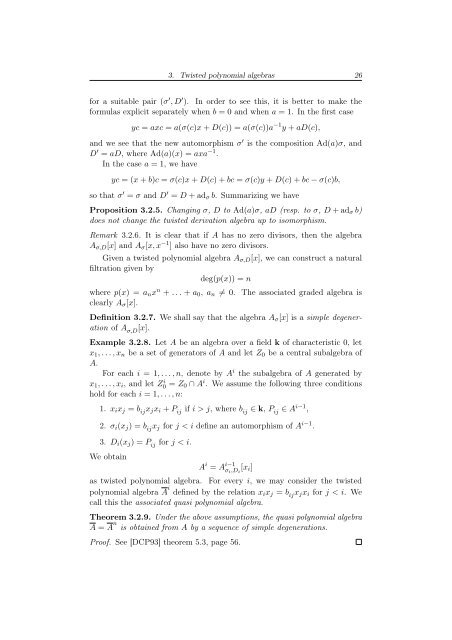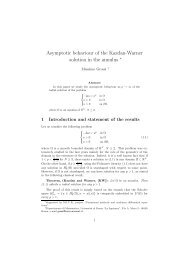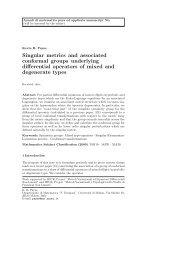Degree of Parabolic Quantum Groups - Dipartimento di Matematica ...
Degree of Parabolic Quantum Groups - Dipartimento di Matematica ...
Degree of Parabolic Quantum Groups - Dipartimento di Matematica ...
Create successful ePaper yourself
Turn your PDF publications into a flip-book with our unique Google optimized e-Paper software.
3. Twisted polynomial algebras 26<br />
for a suitable pair (σ ′ , D ′ ). In order to see this, it is better to make the<br />
formulas explicit separately when b = 0 and when a = 1. In the first case<br />
yc = axc = a(σ(c)x + D(c)) = a(σ(c))a −1 y + aD(c),<br />
and we see that the new automorphism σ ′ is the composition Ad(a)σ, and<br />
D ′ = aD, where Ad(a)(x) = axa −1 .<br />
In the case a = 1, we have<br />
yc = (x + b)c = σ(c)x + D(c) + bc = σ(c)y + D(c) + bc − σ(c)b,<br />
so that σ ′ = σ and D ′ = D + adσ b. Summarizing we have<br />
Proposition 3.2.5. Changing σ, D to Ad(a)σ, aD (resp. to σ, D + adσ b)<br />
does not change the twisted derivation algebra up to isomorphism.<br />
Remark 3.2.6. It is clear that if A has no zero <strong>di</strong>visors, then the algebra<br />
Aσ,D[x] and Aσ[x, x −1 ] also have no zero <strong>di</strong>visors.<br />
Given a twisted polynomial algebra Aσ,D[x], we can construct a natural<br />
filtration given by<br />
deg(p(x)) = n<br />
where p(x) = anx n + . . . + a0, an = 0. The associated graded algebra is<br />
clearly Aσ[x].<br />
Definition 3.2.7. We shall say that the algebra Aσ[x] is a simple degeneration<br />
<strong>of</strong> A σ,D [x].<br />
Example 3.2.8. Let A be an algebra over a field k <strong>of</strong> characteristic 0, let<br />
x1, . . .,xn be a set <strong>of</strong> generators <strong>of</strong> A and let Z0 be a central subalgebra <strong>of</strong><br />
A.<br />
For each i = 1, . . .,n, denote by A i the subalgebra <strong>of</strong> A generated by<br />
x1, . . .,xi, and let Z i 0 = Z0 ∩ A i . We assume the following three con<strong>di</strong>tions<br />
hold for each i = 1, . . .,n:<br />
1. xixj = b ij xjxi + P ij if i > j, where b ij ∈ k, P ij ∈ A i−1 ,<br />
2. σi(xj) = b ij xj for j < i define an automorphism <strong>of</strong> A i−1 .<br />
3. Di(xj) = P ij for j < i.<br />
We obtain<br />
A i = A i−1<br />
σi,Di [xi]<br />
as twisted polynomial algebra. For every i, we may consider the twisted<br />
polynomial algebra A i defined by the relation xixj = bijxjxi for j < i. We<br />
call this the associated quasi polynomial algebra.<br />
Theorem 3.2.9. Under the above assumptions, the quasi polynomial algebra<br />
A = A n is obtained from A by a sequence <strong>of</strong> simple degenerations.<br />
Pro<strong>of</strong>. See [DCP93] theorem 5.3, page 56.








